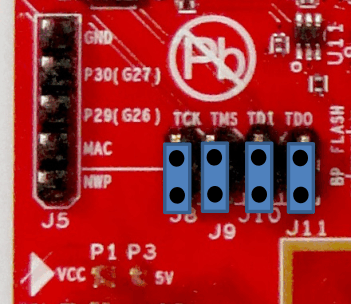SWRU372C June 2014 – March 2020 CC3200
- CC3200 SimpleLink™ Wi-Fi® and Internet of Things Solution With MCU LaunchPad™ Hardware
- Revision History
2.4.1 JTAG Headers
The headers are provided on the board to isolate the CC3200 device from the mounted FTDI JTAG emulator. These jumpers are shorted by default when the board is shipped from TI. To connect an external emulator, remove these jumpers and place the external emulator on the pins closer to the CC3200 device. When a battery is used, disconnect all the JTAG headers to prevent any reverse leakage current.
Figure 4. JTAG Headers
